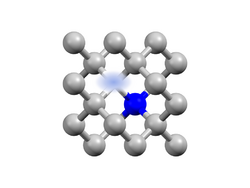Physics:Optically detected magnetic resonance
In physics, optically detected magnetic resonance (ODMR) is a double resonance technique by which the electron spin state of a crystal defect may be optically pumped for spin initialisation and readout.[1] Like electron paramagnetic resonance (EPR), ODMR makes use of the Zeeman effect in unpaired electrons. The negatively charged nitrogen vacancy centre (NV−) has been the target of considerable interest with regards to performing experiments using ODMR.[2]
ODMR of NV−s in diamond has applications in magnetometry[3] and sensing, biomedical imaging, quantum information and the exploration of fundamental physics.
NV ODMR
The nitrogen vacancy defect in diamond consists of a single substitutional nitrogen atom (replacing one carbon atom) and an adjacent gap, or vacancy, in the lattice where normally a carbon atom would be located.

The nitrogen vacancy occurs in three possible charge states: positive (NV+), neutral (NV0) and negative (NV−).[4] As NV− is the only one of these charge states which has shown to be ODMR active, it is often referred to simply as the NV.
The energy level structure of the NV− consists of a triplet ground state, a triplet excited state and two singlet states. Under resonant optical excitation, the NV may be raised from the triplet ground state to the triplet excited state. The centre may then return to the ground state via two routes; by the emission of a photon of 637 nm in the zero phonon line (ZPL) (or longer wavelength from the phonon sideband) or alternatively via the aforementioned singlet states through intersystem crossing and the emission of a 1042 nm photon. A return to the ground state via the latter route will preferentially result in the [math]\displaystyle{ m_s = 0 }[/math] state.
Relaxation to the [math]\displaystyle{ m_s = 0 }[/math] state necessarily results in a decrease in visible wavelength fluorescence (as the emitted photon is in the infrared range). Microwave pumping at a resonant frequency of [math]\displaystyle{ \nu = 2.87\text{ }GHz }[/math] places the centre in the degenerate [math]\displaystyle{ m_s = \pm 1 }[/math] state. The application of a magnetic field lifts this degeneracy, causing Zeeman splitting and the decrease of fluorescence at two resonant frequencies, given by [math]\displaystyle{ h\nu = g_e\mu_{B} B_0 }[/math], where [math]\displaystyle{ h }[/math] is the Planck constant, [math]\displaystyle{ g_e }[/math] is the electron g-factor and [math]\displaystyle{ \mu_B }[/math] is the Bohr magneton. Sweeping the microwave field through these frequencies results in two characteristic dips in the observed fluorescence, the separation between which enables determination of the strength of the magnetic field [math]\displaystyle{ B_0 }[/math].

Hyperfine splitting
Further splitting in the fluorescence spectrum may occur due to the hyperfine interaction which leads to further resonance conditions and corresponding spectral lines. In NV ODMR, this detailed structure usually originates from nitrogen and carbon-13 atoms near to the defect. These atoms have small magnetic fields which interact with the spectral lines from the NV, causing further splitting.
References
- ↑ Delaney, P; Greer, JC (Feb 2010). "Spin-Polarization Mechanisms of the Nitrogen-Vacancy Center in Diamond". Nano Letters 10 (2): 610–614. doi:10.1021/nl903646p. PMID 20085271. Bibcode: 2010NanoL..10..610D. https://pure.qub.ac.uk/portal/files/644605/Delaney_Greer_Larsson_Spin_Polarization_Mechanisms_of_the_Nitrogen-Vacancy_Center_in_Diamond_Nanoletters_10_2010_610.pdf. Retrieved 2018-08-09.
- ↑ Clevenson, H; Englund, D (2015). "Broadband magnetometry and temperature sensing with a light-trapping diamond waveguide". Nature Physics 11 (5): 393–397. doi:10.1038/nphys3291. Bibcode: 2015NatPh..11..393C.
- ↑ Chipaux, M; Debussichert, T (2015). "Magnetic imaging with an ensemble of nitrogen vacancy-centers in diamond". European Physical Journal D 69 (7): 69:166. doi:10.1140/epjd/e2015-60080-1. Bibcode: 2015EPJD...69..166C.
- ↑ Pfender, M (2016). "Investigating the positively charged nitrogen-vacancy center in diamond as a long lived quantum memory". APS Meeting Abstracts 2016: R45.006. Bibcode: 2016APS..MARR45006P.
Bibliography
- Wang, J. F.; Liu, L.; Liu, X. D.; Li, Q.; Cui, J. M.; Zhou, D. F.; Zhou, J. Y.; Wei, Y. et al. (23 March 2023). "Chinese Breakthrough in High-Pressure Superconducting Magnetic Detection". Nature Materials (SciTech Daily) 22 (4): 489–494. doi:10.1038/s41563-023-01477-5. PMID 36959503. https://scitechdaily.com/chinese-breakthrough-in-high-pressure-superconducting-magnetic-detection/.
 |

